NAPPSS-IIN Public Media National Action Team Activity: Safe Infant Sleep Registry
There is no shortage of gear that is marketed to parents of babies, and products may promise to solve all your sleep problems. You may get lots of suggestions from friends and relatives or see lists of “need-to-have” products on parenting websites or other media. Here is some advice to help sort through the options:
Introduction
Sudden Unexpected Infant Death (SUID), or sleep-related infant death, is the single leading cause of death for infants between 1 month and 1 year of age. Every year, about 3,500 healthy babies die in their sleep, and their families suffer the devastating heartbreak of losing a child. Many of these deaths can be prevented. Pediatricians and other researchers who study SUID have made recommendations on how best to reduce the risk of sleep-related infant death. Following these recommendations can help keep your baby safe and healthy, and over time, help everyone in your family get the sleep they need.
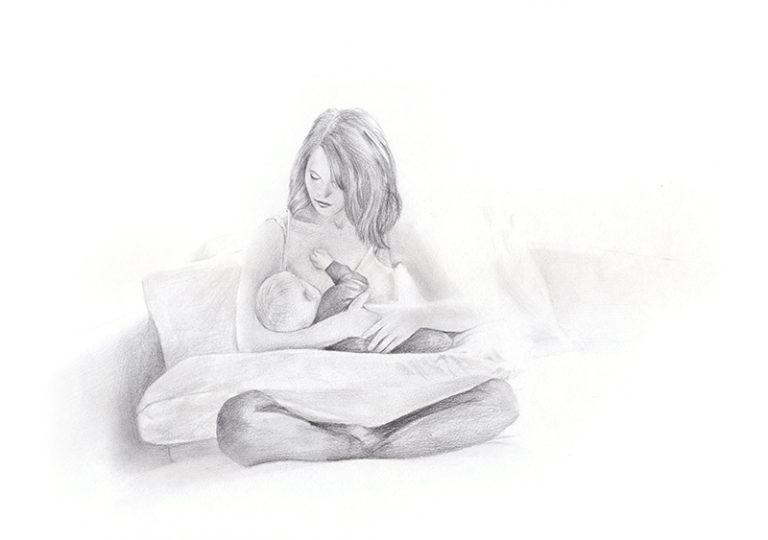
Recommendations for Safe Infant Sleep
- Back to sleep for every sleep. Babies should always be placed on their backs to sleep. This helps keep their breathing clear and does not increase the risk of choking on spit-up. Babies who sleep on the tummy are TWICE as likely to die of SUID. Older babies may roll over, and that’s okay—the important thing is to put the baby on his or her back at the start of sleep time.
- Create a safe sleeping environment. This means that the baby has his or her own space in a crib, bassinet, or play yard with no other people. The sleep surface should be firm and flat, with no pillows, blankets, bumpers, stuffed toys, or other soft items. All you need is a tightly fitting sheet. The best place for your baby to sleep is in your room, but in his or her own space.
- Avoid sleep in unsafe places. Couches, armchairs, and inclined (not flat) sleep products are not safe places for your baby to sleep. It’s okay if your baby falls asleep in the car seat while you are on the move, but when you get to where you are going, it’s safest to move your baby to a crib, bassinet, or play yard.
- Breastfeed your baby if possible. Breastfeeding can help prevent sleep-related death and provides all the nutrition your baby needs for the first months of life.
- Don’t smoke. Exposure to smoke increases the risk of sleep-related death and is not healthy for people of all ages. This is true during your pregnancy and after the baby is born.
- Offer a pacifier at sleep time. Routine use of a pacifier at sleep time greatly reduces the risk of SUID. If your baby refuses the pacifier, that’s okay. If the pacifier falls out of your baby’s mouth, that’s okay too.
Challenges
It may feel impossible for everyone to get enough sleep when you have a baby. It is normal for young infants to wake up during the night. These arousals may actually help prevent sleep-related deaths. Many babies take a long time learning how to sleep at night, leaving parents feeling desperate for rest. It is normal to have a hard time with sleep and does not mean you are doing anything wrong. This will pass as your baby grows and develops better sleep habits.
Sleep patterns may change as your baby grows, and you might find that what was working does not work anymore. Babies can have sleep regressions for many reasons: a growth spurt, teething pain, learning a new skill, a mild illness like an ear infection or cold, or a change in routine. The best thing to do is to keep following safe infant sleep recommendations and to be consistent. It may take some time but sticking with your usual nighttime and naptime routines will help improve your baby’s sleep schedule.
Sometimes it may seem like nothing works to get your baby to sleep. You may hear advice that does not match the safe sleep recommendations from relatives, friends, and other people you trust. It is understandable to want to try anything that might work. But some practices, like sleeping on the tummy or in a car seat, can be dangerous and increase the risk of death. Following the safe sleep recommendations is the best way to keep your baby safe.
Here are some ways your partner and others can help you get through a period of sleep problems:
- Support breastfeeding parents by sharing the nighttime duties. Partners or other support people can help by changing the baby’s diaper, bringing the baby to mom to nurse, putting the baby back in the crib, bassinet, or playpen after feeding, and soothing the baby to sleep.
- Take turns responding to the baby during the night. Partners or others can give the baby a bottle of expressed milk or formula (if not breastfeeding) if he or she is hungry, giving mom a longer stretch of time to sleep.
- Give help during the day. Partners or other support people can attend to the baby so parents can take a nap, or they can help by preparing meals, doing laundry, cleaning, and caring for other children.
- Be patient with your baby, with yourself, and with your partner. All families have sleep challenges when they have a baby. No matter how hard it feels, it will pass.
Understanding Product Safety Standards
These infant sleep products have mandatory standards:
Cribs. All cribs sold in the United States after June 28, 2011, must meet a strong safety standard. These cribs will not have drop sides and will have stronger construction.
Bassinets. All bassinets sold in the United States after April 23, 2014, must meet the current standard.
Play yards. All play yards sold in the United States after August 29, 2012, must meet the current standard. Play yards are sometimes referred to as Pack ‘n Plays after a common brand of this product.
There is no shortage of gear that is marketed to parents of babies, and products may promise to solve all your sleep problems. You may get lots of suggestions from friends and relatives or see lists of “need-to-have” products on parenting websites or other media. Here is some advice to help sort through the options:
Look for products that meet a mandatory product safety standard. The Consumer Product Safety Improvement Act of 2008 started a process of creating mandatory standards for durable juvenile products, like cribs, bassinets, and play yards, as well as other products that are not used for sleep. Standards help ensure that products will work as intended and be safe for your baby.
However, not all products have a safety standard. Manufacturers can design new products that do not fit into an existing category and sell them to families without any safety requirements. Many of these seem like great products, but they may have safety problems that aren’t known until babies are injured or die while using them. To avoid injury or death, safety standards are helpful. For example, millions of inclined sleep products (such as the Fisher-Price Rock ‘n Play) were sold starting in 2009, but they were recalled in 2019 after dozens of babies died in them. A safety standard helps ensure the product will not harm your baby.
Look for products that meet the safe sleep recommendations. Baby sleep products should have a sleep surface that is firm and flat. They should have no soft parts that could block your baby’s breathing. They should allow your baby to sleep on his or her back without needing any restraint.
Look for products that meet your family’s needs. If you don’t have much space, consider using a play yard or non-full-size crib instead of a full-size crib. Bassinets are more compact, but your baby will outgrow them sooner. If you need a safe sleep space at another place, like a relative’s home or with a babysitter, consider a play yard or foldable crib that can be put away when it isn’t needed.
Avoid products that do not meet safe sleep recommendations. Remember, not all products available for sale are safe to use. Things to avoid:
- Crib bumpers. They have no safety purpose and could increase the risk of suffocation or strangulation.
- Pillows, stuffed toys, blankets, and other soft items.
Babies should never sleep on pillows. - Sleep products that hold your baby at an angle.
Babies should sleep flat on their backs.
When in doubt, remember the ABCs of Safe Sleep: a product should allow your baby to sleep Alone in their own space, flat on their Back, in a safe Crib or other safety-tested space.
A safe infant sleep product registry
for new parents
What kind of sleep products do you really need? Here is a list of items that will help keep your baby safe while sleeping:
| Category | Items | Examples |
| Safe sleep space | Crib, bassinet, or play yard | 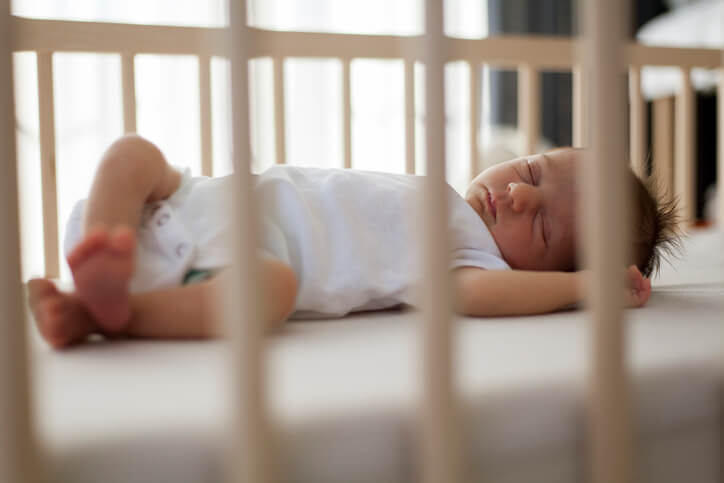 |
| Sleep clothing | Footed sleepers, wearable blankets | 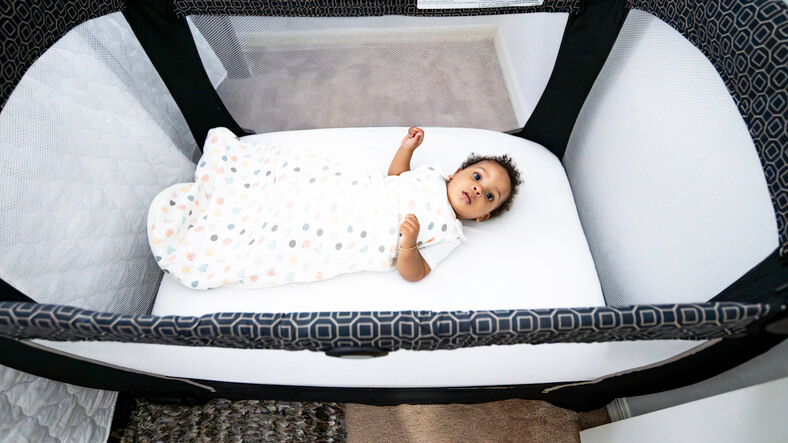 |
| Sleep accessories | White noise machine, mobile (for babies younger than 6 months), monitor | 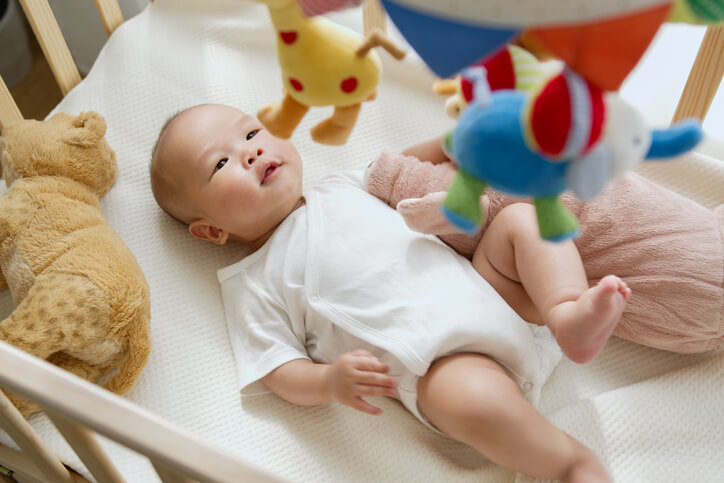 |
| Breastfeeding support gear | Pumping equipment, nursing clothes | 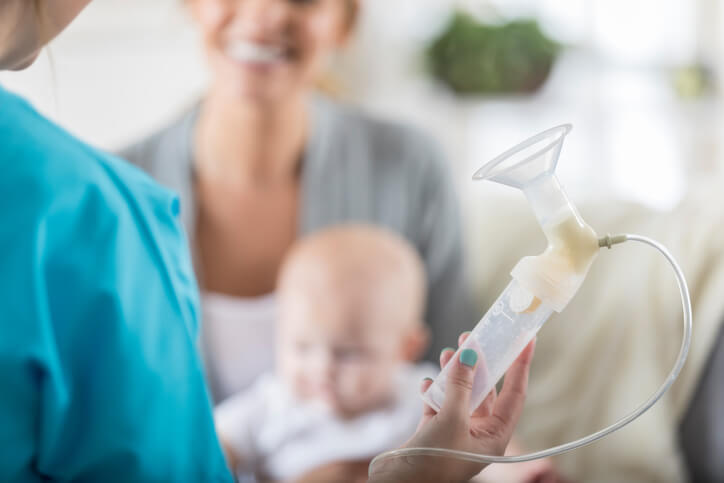 |
Where to Get Support
Babies need a lot of love and attention, and some necessary products. Think about where you will go to get a safe sleep space and other essentials, like diapers, clothing and nutritional support for mom and baby. You also may need support establishing and maintaining breastfeeding or finding a pediatrician for your baby. Organizations in your community can help you make sure your baby’s needs are met:
Examples:
- Cribs for Kids
- La Leche League
- WIC
- Head Start/Early Head Start
- Community health center
- Healthy Start
- Home visitors
What About Hand Me Downs
Family and friends can be a great source of gear that has already served them well. Keep these rules in mind for using secondhand baby equipment:
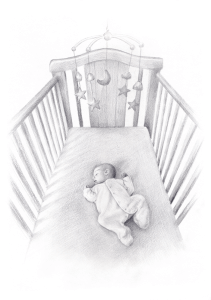
- Cribs, bassinets, and play yards should not be older than the current safety standard. If they are too old, your baby may be injured by a product flaw that does not exist in newer products. It would be better to use a less expensive product that is new than an older product that has unsafe features, like a crib with a drop side.
- Hand-me-down sleep gear should only be accepted from friends or relatives you know and trust. It is best not to purchase baby sleep gear from internet marketplace groups or thrift stores, as it may have hidden damage, be assembled incorrectly, or be older than it appears.
- Babies outgrow their infant sleep space in a few short years! If yours meets the current safety standard, and is in good condition, consider passing it on to another family that needs a safe place for their new baby to sleep.
